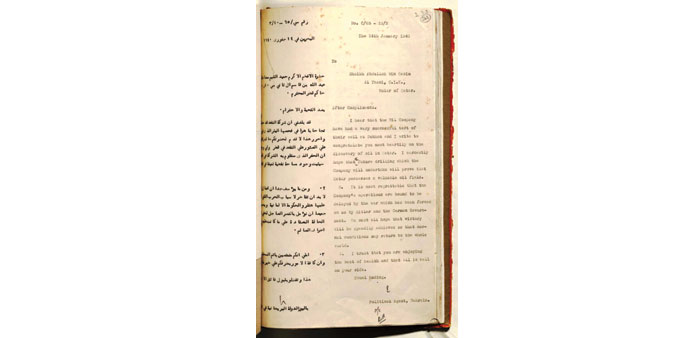Letter from the Political Agent, Bahrain, to Shaikh Abdullah bin Jasim al-Thani, dated 14 January 1940. Photo: QDL
By Anand Holla
In light of the recent Qatar National Day, the Qatar Digital Library (QDL) published an article on the exchanges that took place between Britain and Qatar over the last three centuries.
The article, based on East India Company’s archives, talks about Zubarah’s prominence back in the day and how the discovery of oil forged the relationship between Qatar and the British empire.
QDL (www.qdl.qa) is a portal that is a result of partnership that started in 2012 between Qatar Foundation for Education, Science and Community Development, and British Library, and QNL. The free-for-all, bilingual (English and Arabic) digital information storehouse covers modern history and culture of the Gulf and wider region, available online for the first time ever.
In his piece titled “Qatari History: Pivotal Moments Revealed in India Office Records”, Dr Mark Hobbs, Gulf History Specialist at British Library, draws attention to fascinating nuggets of forgotten history.
“Extending round a shallow bay on the sheltered western shores of the Qatar peninsula, Zubarah occupies a special place in Qatari memory, thanks to its status as one of the earliest and most important trading and pearl fishing ports on the Gulf,” Hobbs writes, “Very little remains of Zubarah now, having been long since abandoned, but its relevance to the history of the region has been recognised by Unesco, which has designated the town as Qatar’s first World Heritage site.”
Documents contained in the archives of the East India Company reaffirm Zubarah’s prominent position in the Gulf at the end of the eighteenth century, he further points out. “Moreover, they offer us a rich insight into Qatar’s development since that time,” he says.
As for Qatar’s coastline, throughout the 1820s, Hobbs points out, Britain’s Indian Navy carried out the most comprehensive survey of the Gulf’s coastal waters to date, using modern trigonometric surveying methods. He, then, explores the 1868 agreement between Qatar and the British, before emphasising on how the discovery of oil changed dynamics.
“The discovery of oil across the Middle East and Gulf region saw Britain forge closer ties with Qatar. In 1935, Shaikh Abdullah bin Jasim al-Thani signed an exploratory oil concession with the Anglo-Persian Oil Company. Four years later, the first significant evidence of oil deposits in Qatar were found at rig number one in the west of the country,” Hobbs writes.
His piece cites a telegram from the Bahrain Political Agent, to the Political Resident, dated 11 October 1939, which read ‘Petroleum Development Qatar have had slight show of oil in their test well near Zekrit. Drilling continues’. Later, on 14 January 1940, the Bahrain Political Agent wrote to Shaikh Abdullah to personally congratulate him on the discovery of oil in Qatar, stating that he ‘earnestly hoped that future drilling will prove that Qatar possesses a valuable oil field’. That would turn out to be true.
QDL includes archives, maps, manuscripts, sound recordings, photographs and much more, complete with contextualised explanatory notes and links, in both English and Arabic. It showcases everything from Arabic Scientific Manuscripts from the British Library’s Manuscripts Collections, covering topics such as medicine, mathematics, astronomy and engineering, to 500 maps, charts and plans of the Persian Gulf and the wider region.
Its sweep spans from a selection of photographs, postcards and other printed objects as well as sketches, drawings and watercolours; etchings, engravings and illustrations, to a selection of audio collection materials including 200 shellac discs recorded in Bahrain, Kuwait and Iraq between 1920 and 1940.

